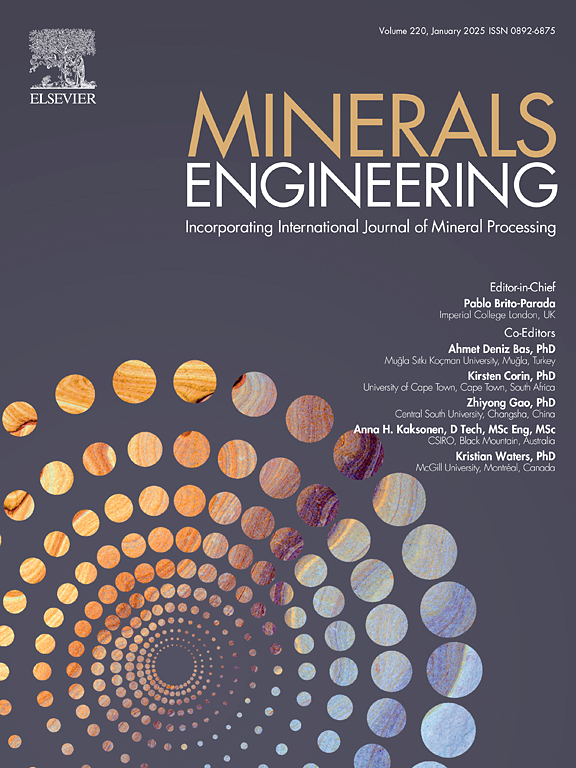橄榄石矿物的硫酸盐活化矿物碳化,用收缩岩心模型和机器学习算法解释其机理
IF 4.9
2区 工程技术
Q1 ENGINEERING, CHEMICAL
引用次数: 0
摘要
过去曾对橄榄石矿物的直接水溶液矿物碳化进行过广泛研究。然而,无机电解质(尤其是硫酸钠(Na2SO4))对矿物碳化速率的影响尚未得到研究。在这项工作中,我们报告了在水热条件下,使用 Na2SO4 和氯化钠(NaCl)作为无机催化剂,研究富含超细橄榄石的二氧化碳吸收率的实验结果。该反应机理是通过收缩岩心模型和机器学习模型来解释的。一个出乎意料的重要发现是,与使用氯化钠(NaCl)作为无机电解质和不使用氯化钠(NaCl)作为无机电解质的基线相比,使用 Na2SO4 能显著提高碳化效率。结果表明,Na2SO4 的存在明显提高了碳化动力学,尤其是在 145-185 °C 的温度范围内。在此温度范围内,反应动力学主要受产物层扩散控制机制的支配。Na2SO4 电解质的存在很可能促进了寄主岩石/矿物中二氧化硅和二价离子的溶解。机器学习建模的结果证实,与其他工艺变量相比,温度和 Na2SO4 添加剂是矿物碳化的关键参数。本研究证明了 Na2SO4 在橄榄石矿物直接水溶液矿物碳化过程中的催化作用。本文章由计算机程序翻译,如有差异,请以英文原文为准。
Sulfate-activated mineral carbonation of olivine minerals with mechanisms explained by shrinking core models and by machine learning algorithm
Direct aqueous mineral carbonation of olivine minerals has been extensively investigated in the past. However, the effect of inorganic electrolytes, particularly sodium sulfate (Na2SO4), on mineral carbonation rate has not been investigated yet. In this work, we report experimental results on the CO2 uptake rate of ultrafine olivine-rich rocks using Na2SO4 and sodium chloride (NaCl) as inorganic catalysts under hydrothermal conditions. The reaction mechanism was explained using both a shrinking core model and a machine learning model. One major and unexpected finding was that the use of Na2SO4 significantly increased the carbonation efficiency compared to the baseline with and without using sodium chloride (NaCl) as an inorganic electrolyte. The results showed that an increase in the carbonation kinetics in the presence of Na2SO4 was evident, particularly at a temperature range of 145–185 °C. At this temperature range, the reaction kinetics are predominantly governed by the product layer diffusion control mechanism. The presence of Na2SO4 electrolyte likely contributed to a promoted dissolution of silica and divalent ions from the hosting rocks/minerals. Results obtained from machine learning modelling confirmed that both the temperature and Na2SO4 additive were key parameters for mineral carbonation compared with other process variables. The present study demonstrates the catalyzing role of Na2SO4 in direct aqueous mineral carbonation of olivine minerals.
求助全文
通过发布文献求助,成功后即可免费获取论文全文。
去求助
来源期刊

Minerals Engineering
工程技术-工程:化工
CiteScore
8.70
自引率
18.80%
发文量
519
审稿时长
81 days
期刊介绍:
The purpose of the journal is to provide for the rapid publication of topical papers featuring the latest developments in the allied fields of mineral processing and extractive metallurgy. Its wide ranging coverage of research and practical (operating) topics includes physical separation methods, such as comminution, flotation concentration and dewatering, chemical methods such as bio-, hydro-, and electro-metallurgy, analytical techniques, process control, simulation and instrumentation, and mineralogical aspects of processing. Environmental issues, particularly those pertaining to sustainable development, will also be strongly covered.
 求助内容:
求助内容: 应助结果提醒方式:
应助结果提醒方式:


